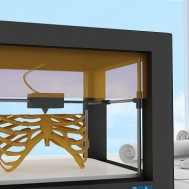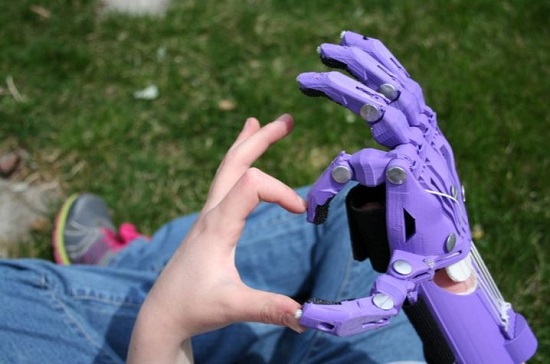There are approximately 10 to 15 million amputees in the world, according to Forbes. Despite the pain and challenges that come with prosthetic limbs, there are also promising benefits: low costs, fast speeds and total versatility for patients.
Let’s take a look at how continued innovation has pushed 3-D printing into new realms — and just how far the technology has come since its invention 30 years ago.
Why 3D Printing for Prosthetics?
Costs for a prosthetic arm can run about $40,000. One in 2,000 kids are born with some kind of an arm or hand abnormality, and do not opt for prosthetics because it doesn’t make much sense to spend that much money on something they will outgrow in a year. 3-D printers, however, make prosthetics for close to nothing. Instead of $40,000, you can do it with about $10 or $20 worth of plastic. If you outgrow it or break it, you can easily make another.
3D printing is the process of creating solid, three-dimensional objects from digital files. The process is additive, which means that layers upon layers of material are laid down in succession until the desired object is created. It melts thin plastic filament and squeezes it through a nozzle, building up computer-generated renderings layer by layer.The chosen material for prosthetics is often thermoplastic, which provides durability and customizable design. Using these printers, you can create almost anything — including body parts — and change lives for many patients.
e-NABLE: Changing the Game for Children
Jon Schull, research scientist at the Rochester Institute of Technology, had an idea to harness an online community of problem solvers to work toward one goal: provide 3D-printable prosthetics to kids in need.
The online community, e-NABLE, turned into a global network of almost 6,000 volunteers — printing over 1,500 devices in 50 countries — and continues to grow at a rapid pace. They lead the way by designing, building, and disseminating inexpensive and functional 3D-printed prosthetics.
“What we do is make mechanical hands for children who are missing fingers using 3-D printers, and we give them away for free,” says Schull. “Just like printing a document, you press print and the 3-D printer starts building this object that you designed on the screen by putting down tiny thin layers of plastic like a glue gun, layer by layer, building up to make the piece.”
The wrist and elbow prosthetics cost only $30-$50 a piece, and require up to three days worth of printer time and assembly.
3D printing: The Bigger Picture
Prosthetics are vital for patients who need them, but their cost can also go up to $100,000. 3-D printing allows these projects to be cut down to $1,000 and under.
Military. 3D printers have helped meet the needs for new advances in prosthetics that cater to military amputees. The Girls’ Lounge recently teamed up with Veteran’s Affairs and Stratasys to help address the needs for female-specific prosthetic devices as part of the VA’S Innovation Creation Challenge. The teams of makers were tasked with developing assistive devices that would improve the care and quality of life for veterans.
“The beauty of 3-D printing is the ability to constantly iterate, prototype and test designs immediately,” notes Dara Dotz, The Girls’ Lounge team member. “With our design, we were able to 3-D print and test our design within 24 hours versus if you were actually making the product with traditional forms of manufacturing—using molds that would cost thousands of dollars and from weeks to months to produce.”
These innovative designs need to be accessible, because there will come a day when 3-D printers are as common as household DVD players.
“I’m telling these designers not to hoard their intelligence, because it’s so important that we encourage knowledge sharing,” says Sergeant Wiley, one of the 13,000 military casualties resulting in extremity injuries in Iraq between 2003 to 2013. “It’s not just the military or one country in particular that needs these devices, it’s the entire world.”
Medical. Creating traditional prosthetics is very time consuming and destructive, since any modifications to the prosthetics would destroy the original molds (not to mention the skyrocketing cost to those without significant resources). 3D printing technology assists with customizable prosthetic sockets and implants. Implants are quickly becoming problems of the past, since major hospitals and printing labs can print implants to the correct fit faster than ever before. They can even be planned, manufactured and shipped out in the same day.

Open Bionics has been using 3D printing to make low-cost robotic hands — which can be printed and assembled in just four manufactured parts, produced in 40 hours and costs around $1,000. These robotic hands allow individual finger movement through the use of electromyographical sensors stuck to the amputee’s skin.
3D printing has even helped prosthetics for animals across the globe. The technology has been able to print a toucan’s beak, a sea turtle’s jaw and a dog’s front legs. As far as we can see, the opportunities are endless.
While 3D-printed prosthetics have taken off for a number of different industries, it may still be several years before they are mainstream.
“The biggest hurdle is getting major orthotics companies to get on board. But as 3-D printing becomes cheaper, manufacturers will be forced to adapt,” notes Thomas Most, designer and prosthetics expert with ProofX, a 3D biomedical printing service. “When the companies realize this technology can hurt their wallet if they don’t utilize it, that’s when they’ll take notice.”

